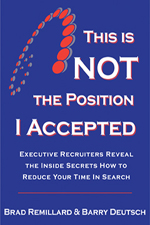Everyone Cares What Your Status is on LinkedIn – Job Search Tactic #5
Let’s take the conversation down from 40,000 ft. to ground level.
As a job seeker, how can you effectively use status updates on LinkedIn for your job search?
Let’s take your example as a management/executive job seeker:
You just responded to a job advertisement at XYZ company.Why not tell your network and ask if anyone knows someone at the company?
Amazing – 4 people in your network knew an executive at the company and would be happy to call on your behalf. Two were vendors, one was a former employee, and one was a key customer. In addition, two people raised their hands and shared with you that they used to work at XYZ company and know the executive in charge of hiring for this position.
You just received a phone call and the company would like you to interview for a position.
Amazing – 3 people in your network have interviewed with that executive before and all had the same type of interview- right down to the 15th question. Now you’re prepared for what may be asked.
You would like to connect with a particular Retained Executive Recruiter – you’ve tried, but you cannot break through the steel door protecting the inner sanctum.
Amazing – you post a status update that you are trying to connect with Barry Deutsch. Within 48 hours, 15 members of your network have responded – 4 executives have used Barry on a search, 7 executives have been placed in key roles by Barry, and 8 executives in your network are customers of IMPACT Hiring Solutions, having bought products and services in the past.
Within 24 hours, 19 people have raised their hands and offered to provide a strong, intimate, hot personal referral to Barry Deutsch that is guaranteed to not only have Barry return the call – but he’ll probably proactively pick up the phone and call you!
This list is endless in the ways you can leverage your LinkedIn Status Updates to communicate and share with your network. Perhaps, most importantly you keep a top-of-the-mind presence with your entire network.
What could be easier – 30 seconds a day each day – and now your name – your brand – is once again in front of your entire network.
I try to vary my status updates. I achieve freshness, interest, and variation through breaking my status updates down into 3 categories
- Sharing something I did that is relevant to my network (by describing what I am doing professionally – not personally such as “Now I’m brushing my teeth” or “Grandma made a mean meatloaf tonight”.
- Sharing something someone else in my network mentioned and I thought it was worthy of sharing with my entire network
- Sharing a link to a great blog post, web page, tool, download, upcoming webinar – something that you felt might be useful to your network.
Remember – one of the basic fundamental elements of effective networking is helping your network – giving back. Status updates is a powerful tool to give back to your network and to be seen as “useful” and “helpful”. This is social networking and social media 101.
Finally, once you’ve done this on LinkedIn, you can extend the same strategies to all the other social media and networking sites. Do you use Google Buzz/Reader to share information with your network? Are you on Facebook and continually updating your status? Twitter is the extreme example of status updating for your network. And there are many other sites.
If you’re not leveraging the real power of social media and networking through status updates – you’re working way too hard to sustain communication with your network.
What was the last status update you did on LinkedIn? When was it – 1 week ago, a month ago, 3 months?
Barry Deutsch
My partner, Brad Remillard, will be leading a powerful webinar on March 26th to teach you how to leverage all the LinkedIn tools to find your next job through LinkedIn.
Are you leaving opportunities on the table because you don’t know how to effectively leverage the tools LinkedIn provides for job seekers?
CLICK HERE to sign up right now for this unique LinkedIn Job Search webinar.
(NO ONE else is teaching anything remotely like this webinar, which is crammed with so many valuable LinkedIn Job Search Action Items that you will not be able to write them down fast enough).









